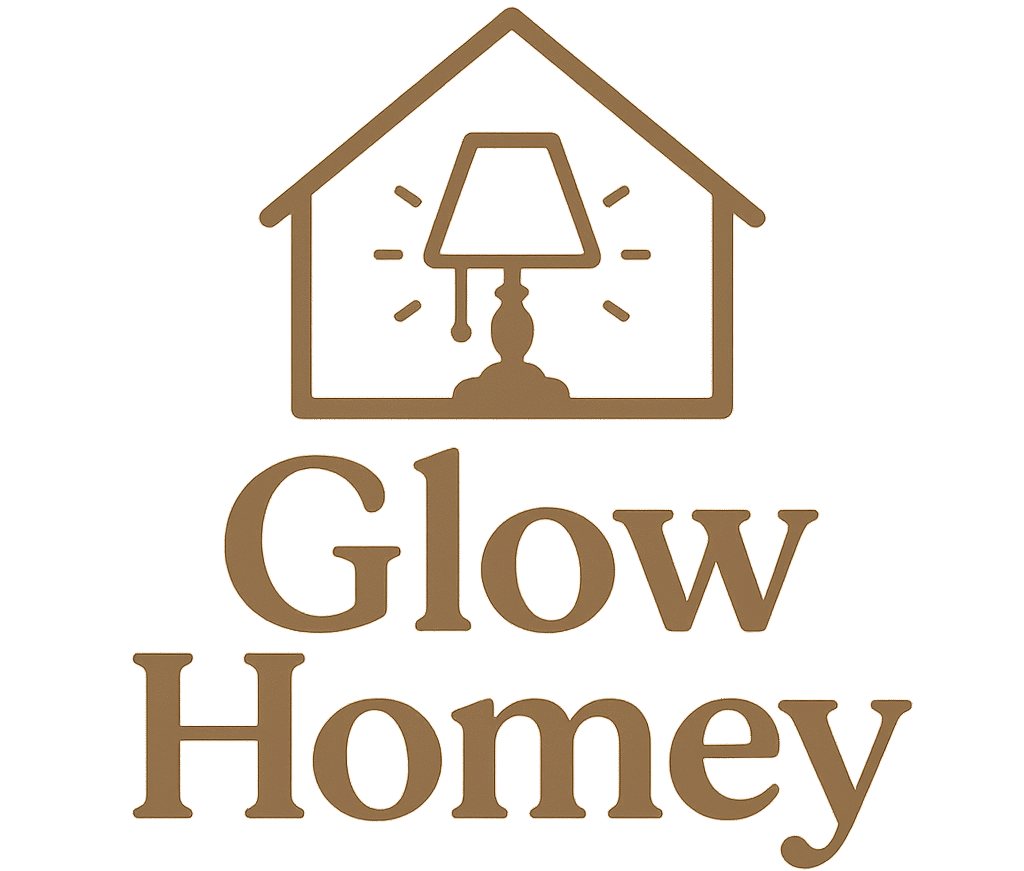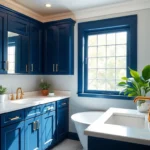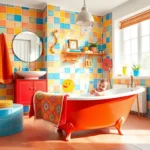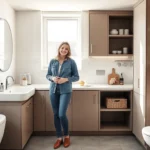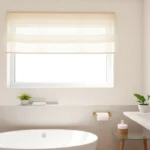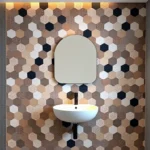Half-tiled bathrooms are taking the design industry by storm and we’re absolutely obsessed with this versatile trend. This brilliant approach combines the durability of ceramic or stone tiles with the warmth of painted walls creating spaces that feel both practical and inviting. Whether you’re working with a tight budget or simply want to add visual interest to your bathroom walls half-tiling offers endless possibilities.
We’ve discovered that strategic tile placement can completely transform how a bathroom feels and functions. From classic subway tiles that reach halfway up the wall to bold geometric patterns that create stunning focal points the options are truly limitless. The beauty lies in the balance – you get all the moisture protection you need in high-splash areas while maintaining design flexibility above.
Ready to explore how half-tiled designs can revolutionize your bathroom? We’ll show you inspiring ideas that prove this trend works beautifully in spaces of every size and style.
Classic Subway Tile Wainscoting Ideas
Subway tiles remain the cornerstone of half-tiled bathroom design, offering timeless appeal that transcends design trends. We’ve seen these rectangular gems transform countless bathrooms through strategic wainscoting applications that balance classic charm with modern functionality.
Traditional White Subway Patterns
White subway tiles create clean lines that brighten any bathroom space while establishing a foundation for versatile design choices. We recommend installing these 3×6-inch tiles in a traditional running bond pattern extending 36-48 inches up the wall for optimal visual impact.
Beveled edges add subtle dimension to white subway installations, catching light and creating gentle shadows that prevent the surface from appearing flat. These tiles work exceptionally well in smaller bathrooms where the reflective quality helps expand the perceived space.
Grout selection dramatically affects the final appearance of white subway wainscoting. We suggest white or light gray grout for seamless looks, while dark grout creates bold grid patterns that emphasize individual tile shapes.
Colored Subway Tile Variations
Sage green subway tiles bring natural tranquility to half-tiled bathroom designs while maintaining the classic rectangular format we love. These earthy tones pair beautifully with white or cream painted walls above the tile line.
Navy blue subway tiles create sophisticated contrast in bathrooms with lighter upper walls, establishing a timeless nautical aesthetic that never goes out of style. We’ve found these darker tiles particularly effective in powder rooms and guest bathrooms.
Soft pink subway tiles offer unexpected warmth in modern bathroom settings, challenging traditional color expectations while preserving the familiar subway shape. These blush tones complement brass fixtures and create inviting feminine spaces.
Charcoal gray subway tiles provide contemporary elegance without sacrificing the classic subway appeal that homeowners consistently request. These darker options hide water spots better than white tiles while maintaining sophisticated visual interest.
Herringbone Subway Arrangements
Herringbone patterns transform standard subway tiles into ever-changing focal points that elevate half-tiled bathroom wainscoting beyond basic installations. We position these tiles at 45-degree angles to create zigzag patterns that add movement to bathroom walls.
Installation complexity increases with herringbone arrangements, requiring precise measurements and careful planning to ensure pattern alignment at corners and edges. Professional installation becomes particularly valuable for these intricate subway tile layouts.
Visual impact multiplies when herringbone subway patterns extend around bathroom perimeters, creating cohesive wainscoting that draws attention while maintaining the practical benefits of tiled lower walls. These arrangements work best in larger bathrooms with sufficient wall space to showcase the pattern.
Color combinations shine in herringbone subway applications, allowing us to alternate between two complementary tile colors or mix different finishes within the same hue family for added depth and interest.
Modern Geometric Half Tile Designs
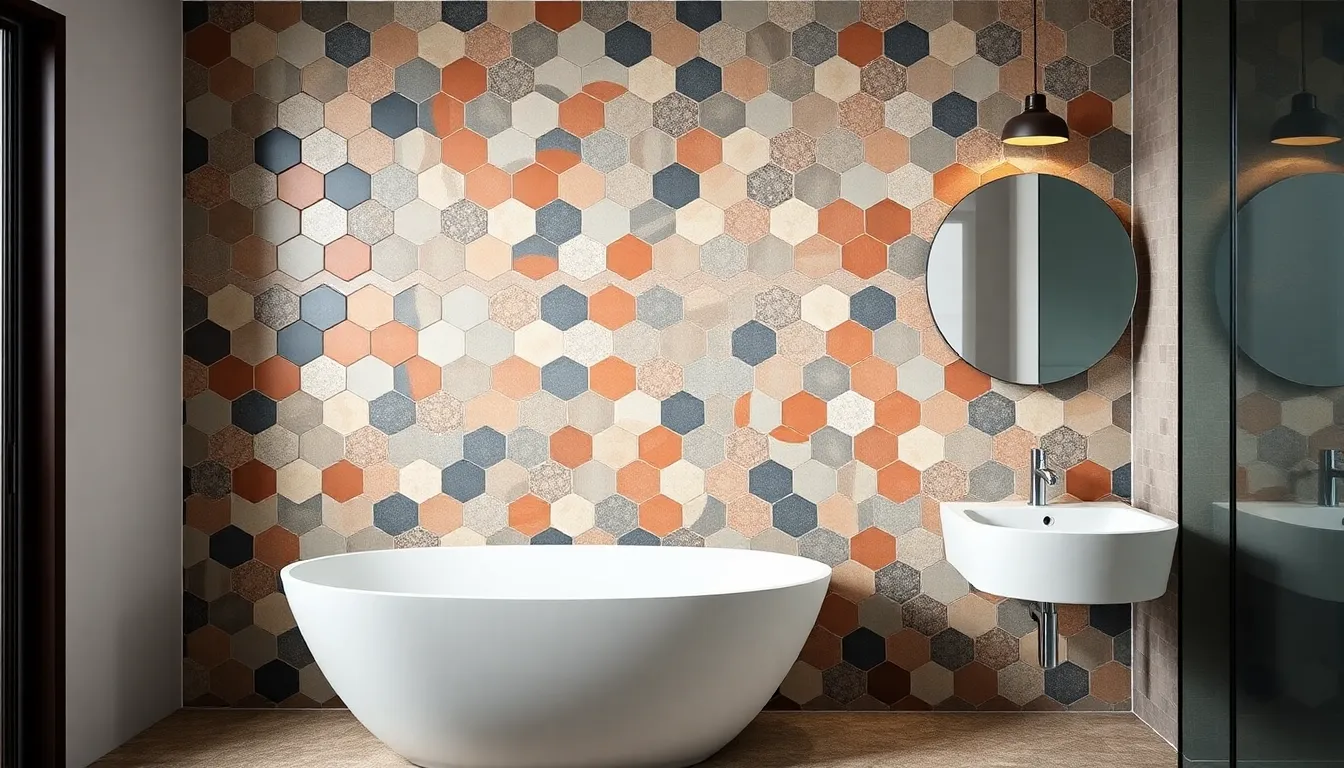
Modern geometric patterns transform half tiled bathrooms into stunning focal points that blend contemporary style with practical functionality. These designs move beyond traditional rectangles to create visual interest and architectural depth.
Hexagonal Tile Accent Walls
Hexagonal tiles create captivating focal points when applied to single walls or exact bathroom areas. We recommend using these six sided shapes to accent the area behind vanities or within shower alcoves for maximum visual impact. The unique geometry naturally draws the eye while maintaining the classic half tile height of 4 to 5 feet.
Pairing hexagonal tiles with traditional square or rectangular tiles on adjacent walls creates striking contrast and dimensional interest. This combination allows you to experiment with different materials and textures while keeping the design cohesive. Consider using white hexagonal tiles with colored grout to emphasize the geometric pattern without overwhelming the space.
Diamond Pattern Applications
Diamond patterns elevate half tiled bathrooms with sophisticated elegance that catches light beautifully throughout the day. We achieve this look by arranging square tiles at 45 degree angles, creating diamond shaped configurations that add visual movement to static walls. This geometric arrangement works particularly well when tiles extend to the standard 4 to 5 foot height mentioned in our design guidelines.
The diamond configuration creates depth and texture that make smaller bathrooms feel more spacious and ever-changing. Consider using glossy tiles in diamond patterns to reflect light and enhance the geometric effect. Matte finish diamonds provide a more subtle approach while still delivering the sophisticated visual appeal this pattern offers.
Triangular Tile Configurations
Triangular tiles bring modern dynamism to half tiled bathroom designs through creative arrangements that form larger geometric patterns. We love using these three sided shapes to create chevron and herringbone designs that add contemporary flair to traditional wainscoting concepts. The angular nature of triangular tiles creates movement and energy within the controlled height parameters of half tile applications.
These configurations work exceptionally well when arranged to form larger diamond or hexagonal shapes across the tiled surface. Consider alternating light and dark triangular tiles to emphasize the geometric pattern and create visual rhythm. The modular nature of triangular tiles allows for endless creative possibilities while maintaining the practical benefits of half tile installation at the recommended 4 to 5 foot height.
Natural Stone Half Tiling Concepts
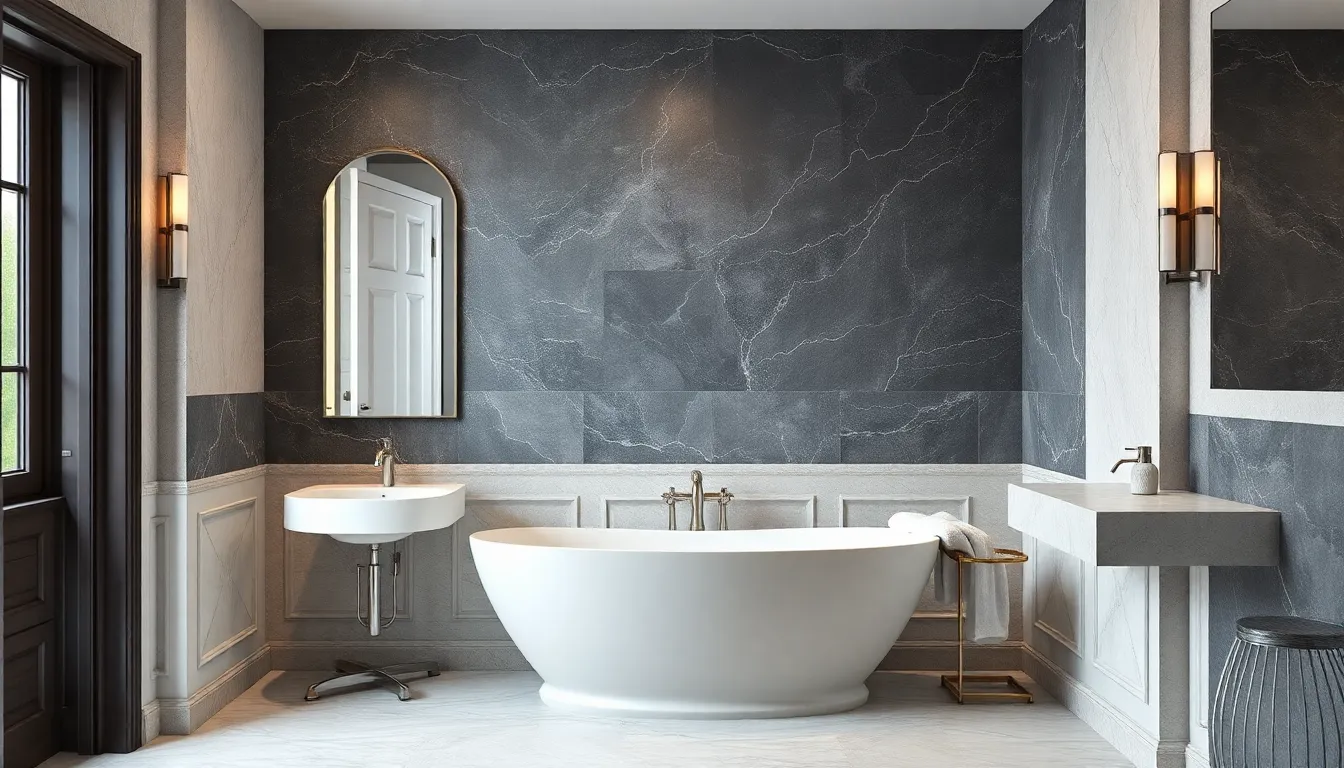
Natural stone transforms half-tiled bathrooms into luxurious retreats while maintaining the cost-effective benefits we’ve explored. Stone materials like marble, slate, and travertine offer unique textures and timeless appeal that synthetic tiles simply can’t match.
Marble Wainscoting Answers
Marble wainscoting creates sophisticated contrast when paired with painted or wallpapered upper walls. We recommend this approach because it delivers both elegance and practicality in a single design solution. The material’s inherent durability and moisture resistance make it ideal for bathroom environments where humidity levels fluctuate.
Visual height adjustments become possible with marble installations, as the lower half application can make ceilings appear lower and spaces feel cozier. Different marble varieties like Carrara, Calacatta, and Emperador offer distinct veining patterns that complement various design aesthetics. Installation typically covers the lower 36 to 48 inches of wall space, creating perfect proportions for most bathroom layouts.
Budget considerations favor marble wainscoting over full-wall installations, reducing material costs while maintaining the luxurious appearance. Maintenance requirements remain minimal with proper sealing, ensuring long-term beauty and functionality.
Slate Accent Wall Ideas
Slate adds dramatic flair to half-tiled bathrooms through its naturally dark and moody characteristics. We’ve found that this material excels at creating atmospheric depth, particularly when contrasted with lighter-colored upper walls. The natural texture inherent in slate surfaces provides visual interest that painted walls cannot achieve.
Color combinations work exceptionally well with slate’s deep tones, allowing homeowners to experiment with cream, white, or soft gray paint choices above the tile line. Natural beauty emerges from slate’s unique geological patterns, making each installation truly one-of-a-kind. Different slate varieties like Welsh, Vermont, and Brazilian offer varying color depths from charcoal to blue-gray.
Installation flexibility allows slate to work in powder rooms, master bathrooms, and guest bathrooms alike. The material’s water resistance ensures longevity in high-moisture environments while requiring minimal maintenance compared to other natural stones.
Travertine Lower Wall Treatments
Travertine brings warmth and texture to bathroom walls while complementing both modern and traditional design elements. We appreciate how this limestone-based material creates inviting atmospheres through its naturally porous surface and neutral color palette. The classic appearance works seamlessly with contemporary fixtures and vintage-inspired accessories.
Moisture resistance capabilities make travertine suitable for bathroom applications, though proper sealing remains essential for optimal performance. Different finishes like tumbled, honed, and filled offer varying aesthetic approaches to achieve desired design goals. Color variations range from ivory and beige to walnut and gold, providing options for diverse decorating schemes.
Temperature regulation benefits emerge from travertine’s natural thermal properties, helping maintain comfortable bathroom environments year-round. Installation costs typically fall between ceramic and premium marble options, making it an accessible luxury material choice for half-tiled applications.
Bold Pattern Half Tile Applications
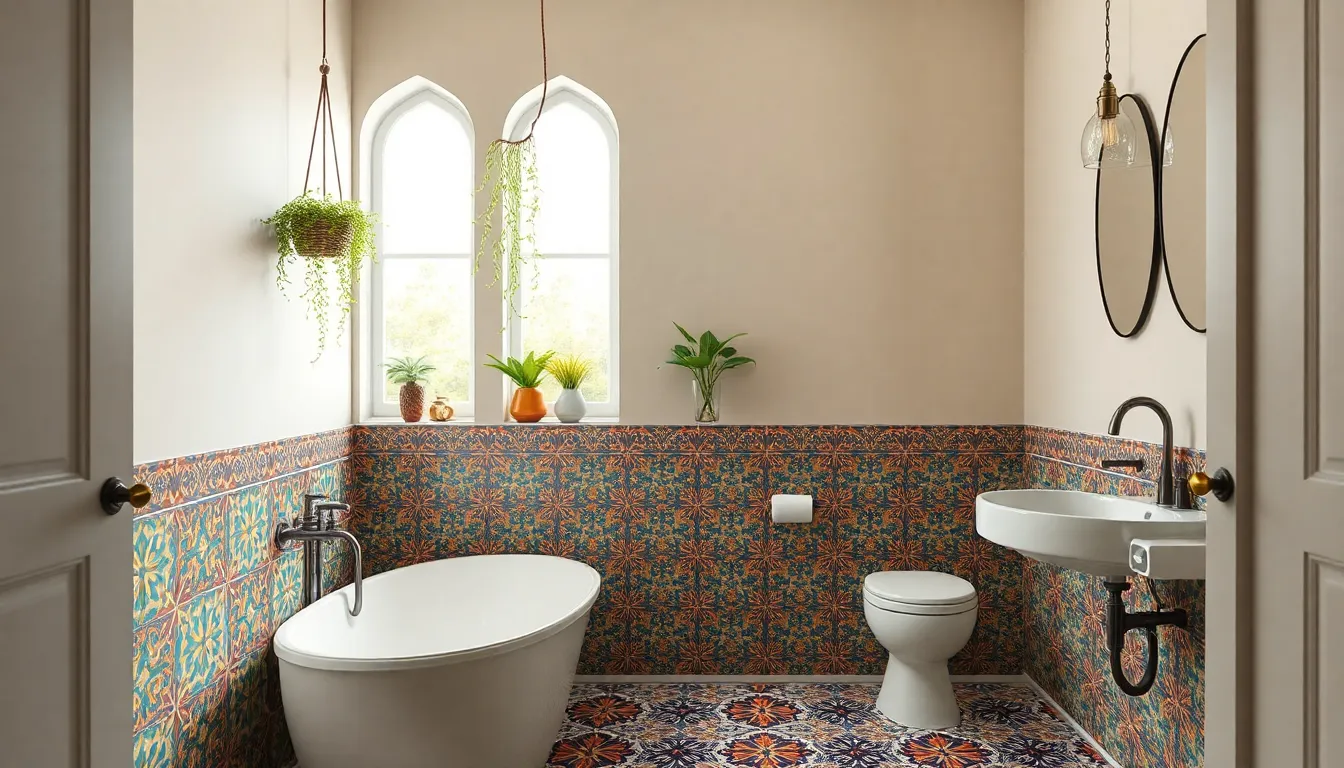
Bold patterns transform ordinary bathrooms into extraordinary spaces that serve as stunning focal points. We’ve discovered that incorporating these eye-catching designs on the lower half of bathroom walls creates maximum visual impact while maintaining cost-effectiveness.
Moroccan-Inspired Designs
Moroccan-inspired tiles bring exotic elegance to half-tiled bathrooms through their intricate, colorful motifs. We recommend using zellige, trellis, or encaustic tiles on the lower wall section to create rich visual texture. These patterns showcase centuries of artisanal heritage with their earthy colors and detailed craftsmanship.
Pairing these ornate tiles with solid neutral paint on the upper walls allows the Moroccan elements to truly shine. We’ve found that this approach prevents overwhelming the space while highlighting the tiles’ authentic beauty. The contrast creates a sophisticated balance that works especially well in powder rooms and guest bathrooms.
Art Deco Style Patterns
Art Deco patterns introduce sophisticated glamour through bold, symmetrical geometric designs inspired by the 1920s and 1930s. We suggest incorporating chevron, herringbone, and stepped motifs to capture this era’s distinctive aesthetic. These high-contrast color schemes create dramatic visual statements that transform any bathroom into a luxurious retreat.
Installing these decorative patterns on the lower half while keeping the upper wall smooth maintains the Art Deco spirit of refined elegance. We’ve observed that black and white combinations work particularly well, though metallic accents can add extra sophistication. The geometric precision of these patterns complements both vintage fixtures and modern amenities.
Floral and Botanical Motifs
Floral and botanical motifs bring nature-inspired artistry to half-tiled bathroom designs with increasing popularity. We’ve seen these tiles range from subtle watercolor effects to vibrant hand-painted murals that mimic botanical scenes. The organic patterns create fresh, inviting atmospheres that make daily routines more enjoyable.
Balancing these bold floral tiles with soft, neutral paint on the upper walls prevents visual overwhelm while maintaining the design’s impact. We recommend this approach particularly for guest bathrooms and powder rooms where you want to make a memorable impression. The combination offers functional moisture protection while showcasing your personality through unique pattern choices.
Textured Tile Half Wall Solutions
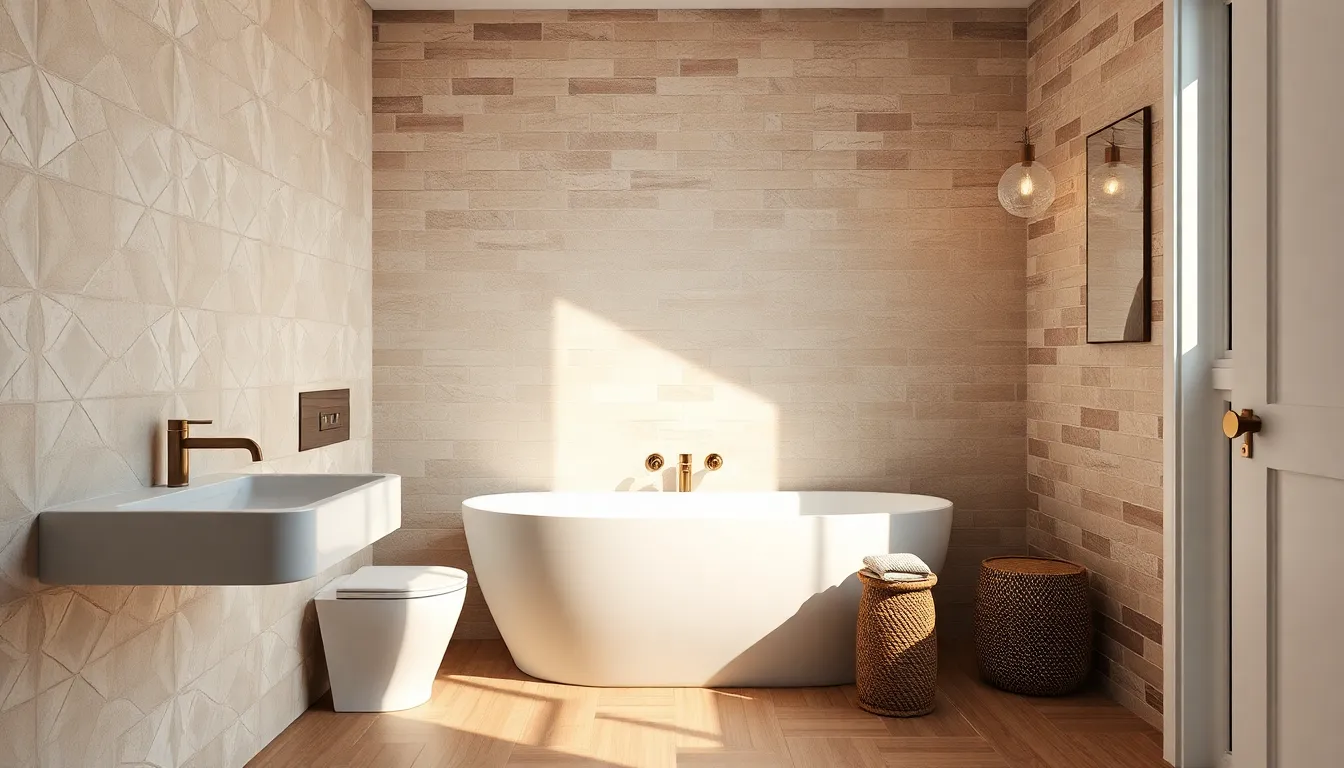
Textured tiles transform half-tiled bathrooms by introducing tactile elements that create visual depth and sophisticated contrast against smooth painted walls. We’re seeing remarkable innovation in textured tile applications that offer both practical benefits and stunning aesthetic appeal.
3D Relief Tile Options
Geometric patterns featuring raised surfaces create striking focal points in half-tiled bathroom designs. These dimensional tiles cast subtle shadows that change throughout the day as natural light shifts across their surfaces. Floral motifs carved into ceramic or porcelain surfaces bring organic elegance to modern bathroom spaces.
Installation techniques for 3D relief tiles require careful consideration of grout spacing and lighting placement. We recommend positioning these textured elements on feature walls behind vanities or bathtubs where they’ll receive optimal illumination. Pairing strategies work best when combining relief tiles with monochromatic upper wall sections that won’t compete for visual attention.
Maintenance considerations make certain relief patterns more practical than others for bathroom environments. Deeper textures can collect moisture and require more frequent cleaning, while subtle raised patterns offer the dimensional interest without creating cleaning challenges.
Brick-Effect Tiling Ideas
Rustic appeal defines brick-effect tiles as they bring urban industrial charm to half-tiled bathroom installations. These ceramic recreations of traditional masonry offer authentic textures without the weight and moisture concerns of actual brick. Staggered arrangements create ever-changing visual patterns that work particularly well in contemporary bathroom designs.
Color variations in brick-effect tiles range from classic red clay tones to weathered gray and whitewashed finishes. We’ve found that darker brick effects create dramatic contrast when paired with light painted upper walls, while lighter brick tones complement neutral color schemes beautifully.
Pattern flexibility allows designers to experiment with running bond layouts or herringbone arrangements using brick-effect tiles. Standard horizontal installations emphasize width in narrow bathrooms, while vertical patterns can make ceilings appear higher in compact powder rooms.
Wood-Look Tile Treatments
Natural warmth emanates from wood-look tiles that replicate various species including oak, maple, and reclaimed barn wood finishes. These porcelain alternatives provide authentic grain patterns and color variations without the maintenance concerns of actual wood in humid bathroom environments. Texture realism has advanced significantly with modern manufacturing techniques that create convincing bark impressions and weathered surfaces.
Installation patterns for wood-look tiles include traditional plank layouts running horizontally or vertically depending on room proportions. We recommend horizontal installations to widen narrow bathrooms and vertical patterns to create height in spaces with standard ceiling dimensions.
Combination strategies work exceptionally well when wood-look tile wainscoting meets painted drywall or natural wood cladding on upper wall sections. This creates cohesive design flow while maintaining the practical benefits of ceramic tile in moisture-prone areas around tubs and showers.
Grout selection becomes crucial with wood-look tiles as contrasting grout can break the wood illusion while matching grout maintains seamless plank appearances. Narrow grout lines enhance the realistic wood effect and make cleaning easier in bathroom applications.
Color Contrast Half Tiling Strategies
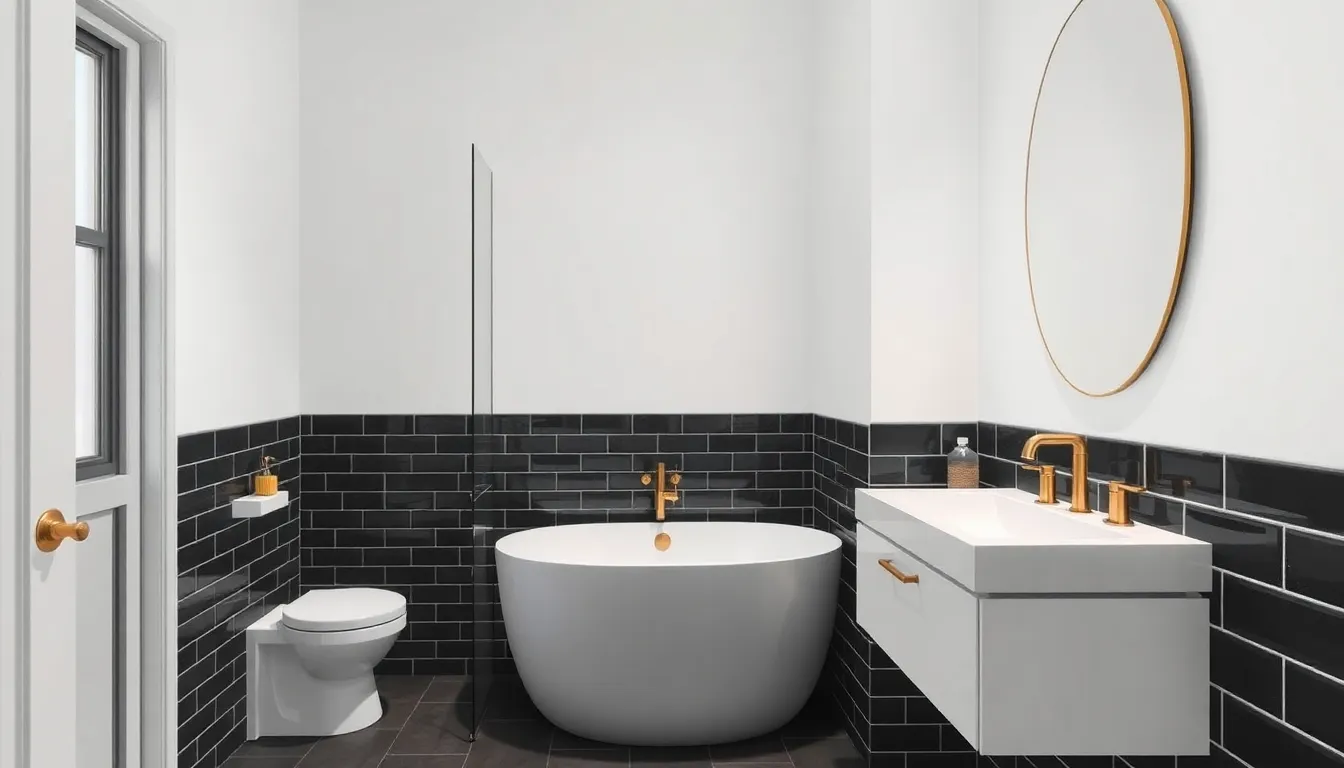
We can transform half-tiled bathrooms by creating striking visual impact through strategic color placement. These approaches help define spaces while maintaining the practical benefits of half-wall tiling.
Dark Bottom Light Top Combinations
Dark bottom light top pairings create dramatic visual weight that grounds your bathroom design. Black marble tiles on the lower half paired with off-white wall color on the upper section deliver strong contrast that makes spaces feel both sophisticated and spacious. Dark charcoal subway tiles combined with crisp white paint above establish classic elegance while hiding water splashes and wear patterns naturally.
Light colored tiles with dark upper walls offer unexpected sophistication for adventurous designers. Warm beige tiles on the bottom section complemented by dark botanical wallpaper create unique contrast that brings personality to powder rooms. This reverse approach works particularly well in larger bathrooms where darker upper sections won’t overwhelm the space.
Installation considerations for contrasting combinations require careful planning of tile height and transition points. We recommend measuring the golden ratio (approximately 60% tile to 40% paint) to achieve balanced proportions that feel natural to the eye.
Monochromatic Gradient Effects
Monochromatic tiling schemes use varying shades of the same color family to create subtle depth without overwhelming contrasts. Light gray tiles at the bottom can transition to medium gray paint above, maintaining color harmony while adding visual interest through tonal variation.
Texture variations within color families enhance monochromatic designs through surface differences rather than color changes. Matte charcoal tiles below paired with glossy charcoal paint above create ever-changing light reflection while maintaining color consistency throughout the space.
Gradual color transitions work best when selecting colors from the same paint strip or tile collection. Choose colors that are 2-3 shades apart to ensure enough contrast without creating jarring breaks in your color flow.
Bold Accent Color Schemes
Accent wall applications using bold colored tiles create focal points while keeping other walls neutral. Emerald green subway tiles on one half-wall paired with white paint and neutral tiles elsewhere establish striking visual anchors without overwhelming smaller bathrooms.
Metallic accent integration elevates bold color schemes through strategic fixture placement. Gold fixtures and hardware highlight jewel toned tiles like sapphire blue or ruby red, creating luxurious feels that justify the investment in premium materials.
Color blocking techniques combine multiple bold colors in geometric arrangements for contemporary appeal. Navy blue tiles on lower sections paired with coral painted upper walls create modern sophistication when balanced with white grout and chrome fixtures.
Small Bathroom Half Tile Maximization
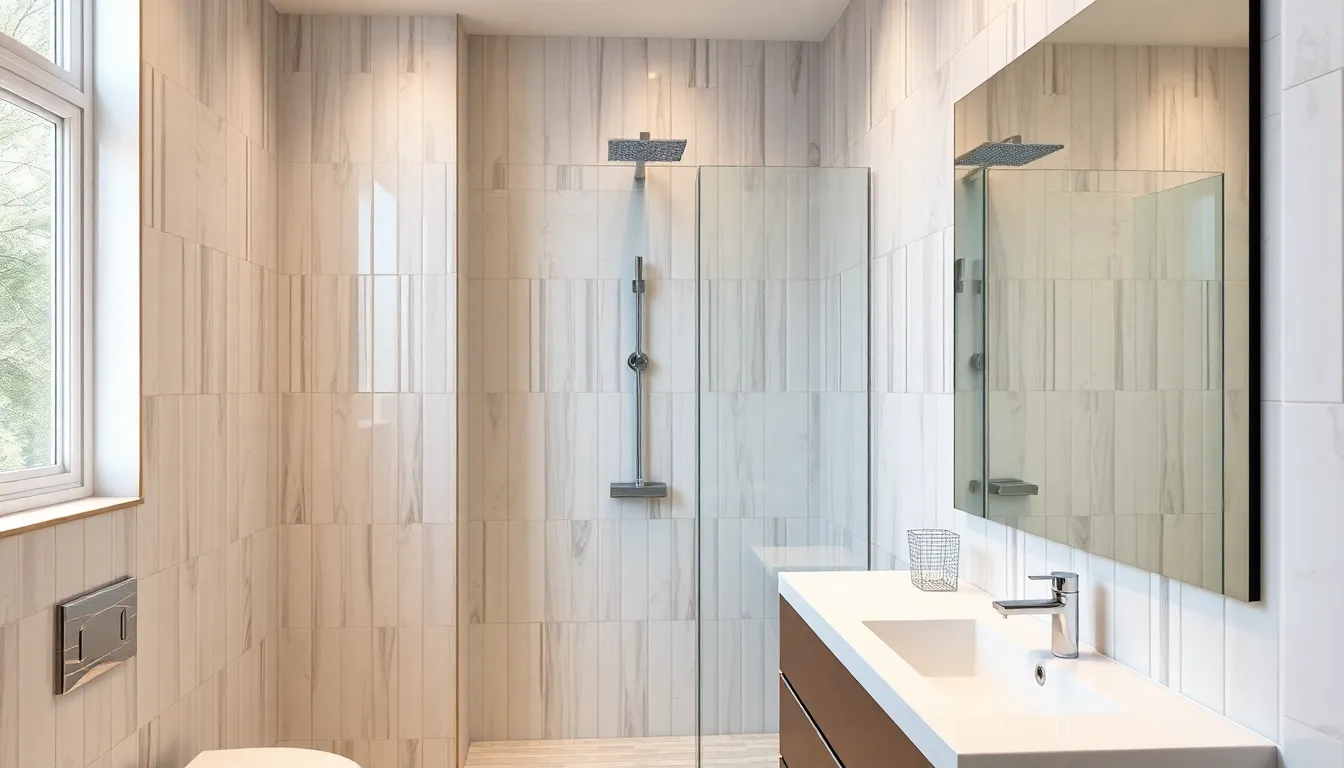
Small bathrooms benefit tremendously from strategic half tiling approaches that create visual expansion while maintaining practical moisture protection. We’ll explore proven techniques that maximize both space perception and functionality in compact bathroom designs.
Space-Improving Tile Placement
Lower wall tiling transforms small bathrooms by establishing visual weight at the foundation while protecting moisture prone areas. We recommend installing tiles up to 4-5 feet high to create optimal proportions that make ceilings appear taller than their actual height.
Horizontal emphasis emerges when we use rectangular tiles in running bond patterns along the lower walls. This technique draws the eye laterally and makes narrow bathrooms feel wider than traditional square tile installations.
Corner emphasis maximizes visual impact by extending half wall tiling around corners in continuous patterns. We’ve found this approach creates seamless flow that eliminates visual breaks and makes small spaces feel more cohesive.
Shower integration connects half tiled walls with shower surrounds to create unified design schemes. This strategy prevents visual fragmentation that can make small bathrooms feel choppy and disconnected.
Vertical Line Creating Techniques
Vertical tile placement creates immediate height illusion by drawing eyes upward toward ceiling lines. We position subway tiles in stack bond patterns rather than traditional offset layouts to emphasize vertical movement and stretch perceived wall height.
Slim tile selection amplifies vertical effects through narrow tile formats that create more grout lines running upward. These additional vertical elements reinforce the upward visual pull and make standard 8 foot ceilings appear significantly taller.
Vertical accent strips introduce contrasting tile colors or textures in narrow vertical bands within half wall designs. We use these strategic accents to break up horizontal tile runs while maintaining the upward visual momentum.
Grout line coordination enhances vertical emphasis when we align grout lines perfectly from floor to tile termination point. This creates uninterrupted vertical paths that guide eyes upward and reinforce height illusions.
Light-Reflecting Tile Choices
Glossy tile finishes bounce available light throughout small bathrooms and create brightness multiplication effects. We select glazed ceramic or porcelain tiles with high sheen levels to maximize light reflection from windows, fixtures, and artificial sources.
Light colored palettes enhance spaciousness through reflective properties that make walls recede visually. White, cream, pale gray, and soft beige tiles work particularly well for reflecting both natural and artificial light sources.
Metallic accent integration introduces subtle shimmer through tiles with metallic glazes or metal tile inserts. These reflective elements catch and redirect light at multiple angles without overwhelming small bathroom spaces.
Mirror coordination amplifies light reflecting effects when we position mirrors strategically above half tiled walls. This combination creates light bouncing between glossy tile surfaces and mirror reflections that dramatically brightens compact spaces.
Budget-Friendly Half Tiling Options
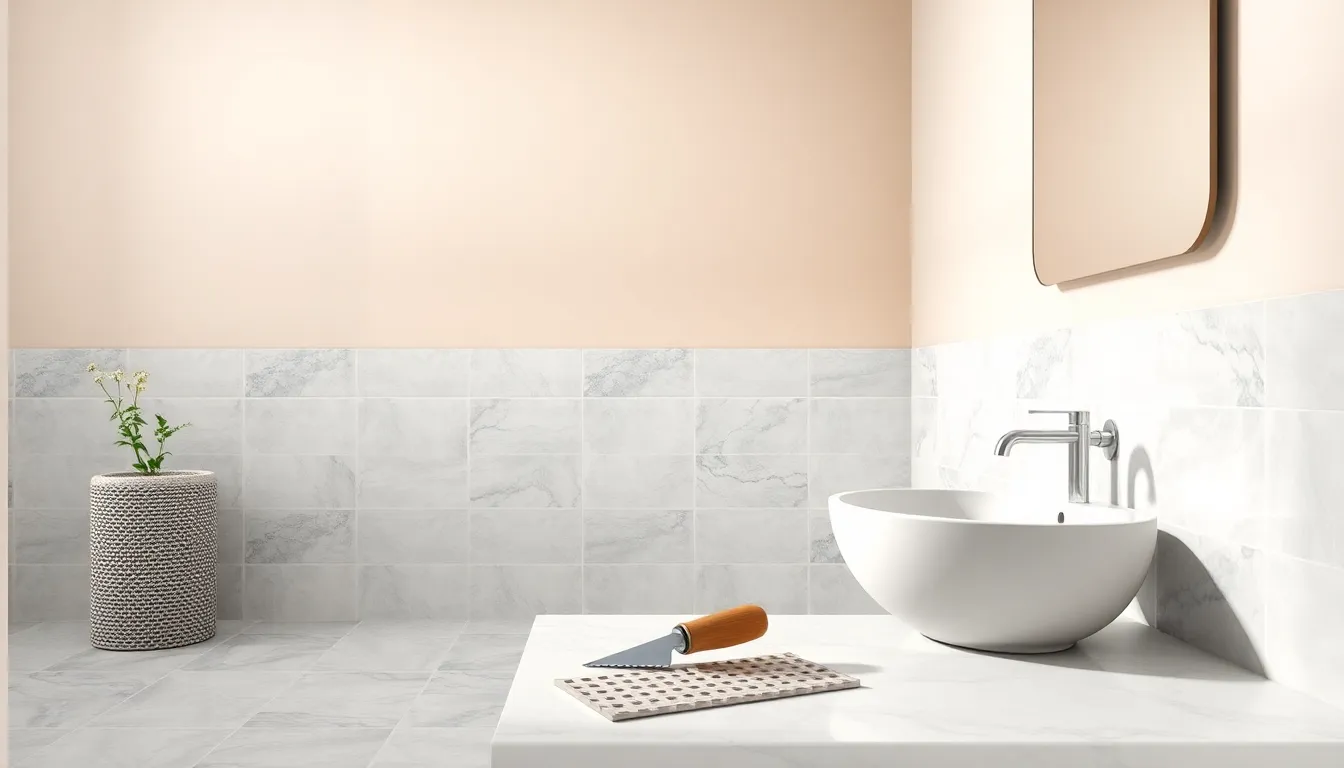
Half tiled bathroom designs offer an accessible pathway to stylish renovations without very costly. We can achieve stunning results by focusing on strategic material choices and smart installation approaches that maximize impact while minimizing costs.
Affordable Ceramic Answers
Ceramic tiles remain our top choice for budget conscious half tiling projects due to their exceptional value and versatility. Large format ceramic tiles cover more wall area per piece, reducing both material quantities and installation time significantly. Classic white or neutral toned ceramic options provide timeless appeal while keeping costs low, typically ranging from $1 to $5 per square foot compared to natural stone alternatives.
We recommend selecting ceramic subway tiles or large rectangular formats for the lower half of bathroom walls, typically extending 4 to 5 feet high. These choices create clean lines and visual continuity while allowing creative freedom with paint colors or wallpaper treatments above the tile line. Neutral ceramics like soft gray, warm beige, or crisp white provide flexibility for future design changes without requiring complete tile replacement.
DIY Installation Techniques
DIY installation becomes manageable with proper planning and the right ceramic tile choices for half wall applications. We suggest starting with large format or standard subway tiles since they require fewer cuts and provide more forgiving installation experiences for beginners.
Preparation steps include measuring and marking a level line at your desired tile height using a laser level or traditional bubble level. Application process involves spreading tile adhesive below the marked line using a notched trowel, ensuring even coverage across the wall surface. Installation technique requires placing tiles with spacers to maintain consistent grout lines, checking level frequently as you progress.
Finishing work includes allowing adhesive to dry completely before grouting, typically 24 hours, then applying grout with diagonal sweeping motions. We estimate that most homeowners can complete a standard half tiled bathroom over one weekend, saving $500 to $1,500 in professional labor costs.
Cost-Effective Material Alternatives
Alternative materials provide creative answers when ceramic tiles exceed budget constraints or design preferences call for different textures. Vinyl wall panels offer moisture resistance and easy installation at roughly half the cost of ceramic tiles, making them ideal for rental properties or temporary answers.
Beadboard wainscoting creates classic charm with minimal investment, typically costing $2 to $4 per square foot installed. Reclaimed or discounted tiles from home improvement clearance sections provide unique patterns and textures at important savings, often 30% to 50% below retail prices.
Mixed material approaches allow combining painted walls, wallpaper, or wood cladding above the tiled sections for enhanced visual interest. We’ve found that pairing basic white ceramic tiles below with bold paint colors or patterned wallpaper above creates dramatic contrasts while maintaining practical moisture protection where it’s needed most.
Luxury Half Tiled Bathroom Features
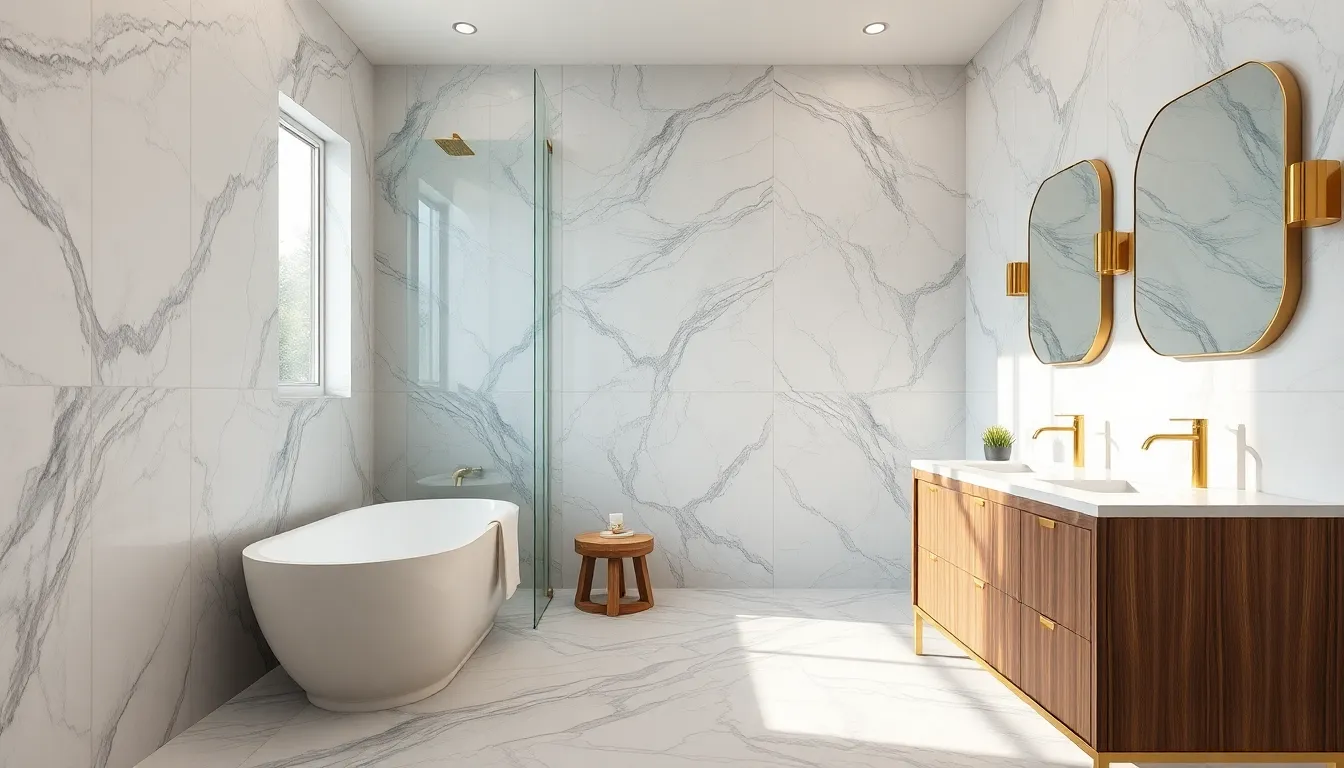
Elevating half tiled bathroom designs into luxury territory requires careful attention to premium materials and sophisticated finishing details. We’ll explore how high-end selections can transform your space into a sophisticated retreat.
Premium Material Selections
Marble tiles dominate luxury bathroom design for their timeless elegance and natural veining patterns. We recommend Carrara or Calacatta marble for half-wall applications, as these varieties offer exceptional durability alongside their renowned aesthetic appeal. Porcelain alternatives provide similar visual impact while offering superior moisture resistance and easier maintenance requirements.
Glass tiles create stunning focal points when applied to accent walls or vanity backsplashes. These materials reflect light beautifully, making smaller bathrooms appear more spacious while adding sophisticated shimmer to the overall design. Frosted glass options provide subtle texture variation while maintaining the clean lines essential to luxury aesthetics.
Natural stone selections like travertine and limestone bring organic beauty to half-tiled installations. These materials offer unique texture variations and warm color palettes that complement both contemporary and traditional luxury design schemes perfectly.
High-End Finish Combinations
Matte and glossy tile pairings create sophisticated contrast within half-tiled bathroom designs. We suggest combining matte marble tiles on lower walls with glossy ceramic accents to achieve visual depth while maintaining practical durability. This technique works particularly well in powder rooms where dramatic impact is desired.
Chrome and gold accent integration elevates tile installations through coordinated fixture selections. Brushed gold faucets and lighting fixtures complement warm-toned tiles beautifully, while chrome accents enhance cool marble and glass selections. These metallic elements should echo throughout the space for cohesive luxury appeal.
Natural material incorporation adds warmth and texture to sophisticated bathroom designs. Wood vanities or stone countertops create beautiful contrast against tiled half-walls, bringing organic elements that soften the overall aesthetic while maintaining luxurious sophistication.
Designer Tile Collections
Handmade artisanal tiles offer exclusive character that mass-produced options simply cannot match. We recommend exploring collections from renowned ceramic artists who create limited-edition pieces with unique glazing techniques and subtle imperfections that add authentic charm to luxury installations.
Unique pattern collections feature intricate geometric designs and sophisticated color combinations. These designer selections often incorporate metallic inlays, textured surfaces, or hand-painted details that create truly distinctive half-wall installations worthy of high-end bathroom designs.
Limited edition series provide exclusivity that enhances the luxury appeal of half-tiled bathroom projects. These collections typically feature innovative manufacturing techniques, rare color combinations, or collaborative designs between renowned artists and tile manufacturers, ensuring your bathroom design remains uniquely sophisticated.
Half Tile Maintenance and Care Tips
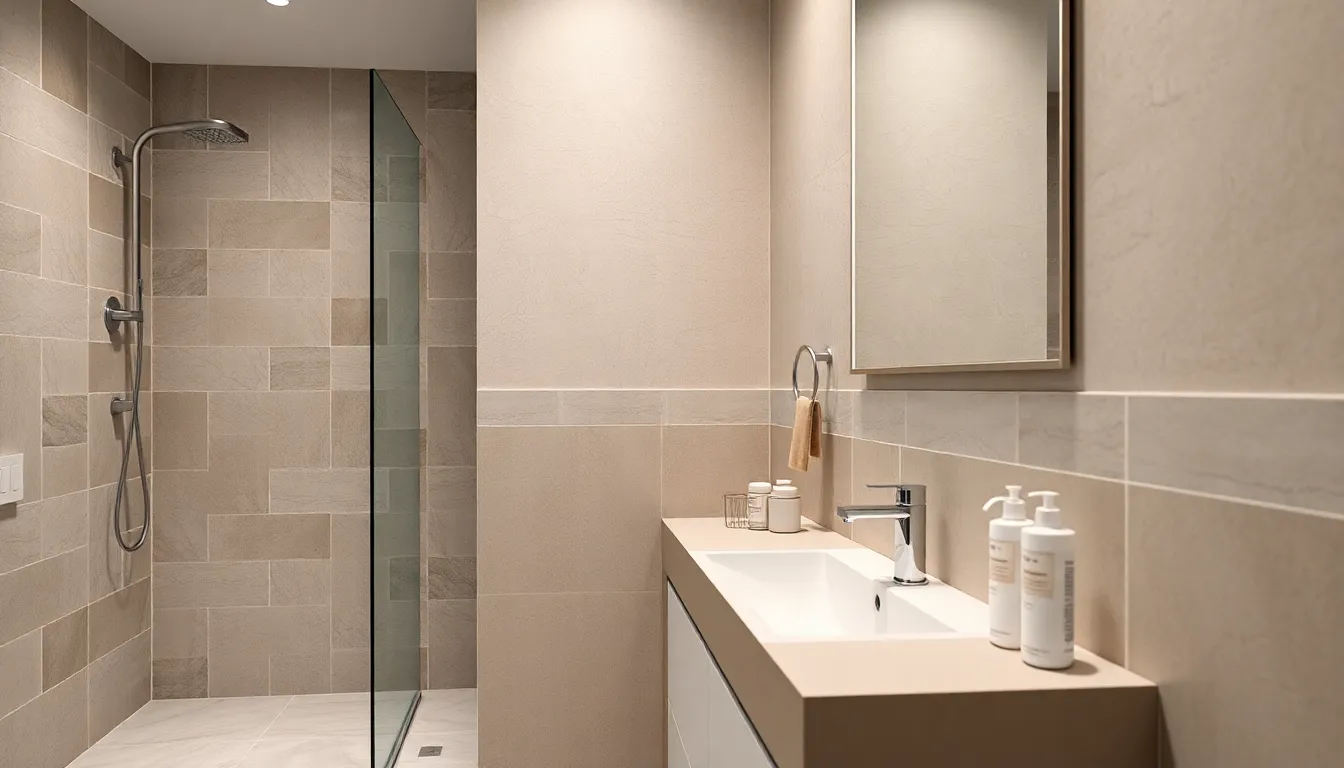
Proper maintenance ensures your half-tiled bathroom continues to showcase its sophisticated design elements while protecting your investment in premium materials.
Cleaning Best Practices
Regular tile cleaning with mild soap and warm water prevents grime buildup that can dull the appearance of your ceramic, porcelain, or natural stone surfaces. We recommend using a microfiber cloth or soft sponge to avoid scratching delicate finishes on marble or glossy tiles.
Weekly maintenance routines should include wiping down tiles immediately after showers to prevent water spots, especially on natural stone materials like travertine or slate. Gentle pH-neutral cleaners work best for natural stone surfaces, while ceramic and porcelain tiles can handle slightly stronger cleaning answers.
Grout line attention requires a soft-bristled brush to remove soap scum and mildew without damaging the grout material. We suggest using an old toothbrush for detailed cleaning around fixtures and corners where buildup commonly occurs.
Specialized cleaning approaches vary by tile material: glass tiles need streak-free glass cleaners, textured 3D relief tiles require extra attention to raised surfaces, and wood-look tiles benefit from cleaners that won’t strip their protective coating.
Grout Protection Methods
Grout sealer application creates a protective barrier against stains and water damage, extending the life of your grout lines significantly. We recommend applying a penetrating sealer to new grout installations after the initial 24-48 hour curing period.
Annual resealing schedules help maintain optimal protection, though high-traffic areas or shower zones may require more frequent attention every 6-8 months. Quality sealers typically last 12-18 months under normal bathroom conditions.
Stain prevention techniques include immediate cleanup of soap residue, toothpaste, and other bathroom products that can discolor unsealed grout. We suggest keeping a squeegee handy to remove excess water from tiled surfaces after each use.
Color-matched grout options allow for easy touch-up repairs when minor damage occurs, maintaining the seamless appearance of your half-tiled design. Professional-grade grout pens can address small stains or discoloration between major maintenance sessions.
Long-Term Preservation Strategies
Periodic deep cleaning every 3-4 months removes built-up residue that regular cleaning might miss, particularly important for textured tiles and natural stone materials. We recommend scheduling this maintenance to coincide with seasonal bathroom updates.
Ventilation optimization prevents moisture damage by ensuring adequate air circulation around your half-tiled surfaces. Exhaust fans should run for at least 30 minutes after showers to reduce humidity levels that can compromise grout integrity.
Professional inspection schedules every 2-3 years help identify potential issues before they become costly repairs, especially for natural stone installations or intricate geometric patterns that require specialized attention.
Damage prevention measures include using bath mats to reduce water exposure, avoiding harsh chemicals like bleach or ammonia on natural stone, and addressing loose tiles immediately to prevent water infiltration behind the tile surface.
Conclusion
Half-tiled bathrooms offer the perfect balance between functionality and style that we’ve all been searching for. From classic subway tiles to bold geometric patterns these designs prove that you don’t need to tile floor to ceiling to create stunning visual impact.
Whether you’re drawn to natural stone elegance luxury finishes or textured surfaces there’s a half-tiling solution that’ll transform your space. The key lies in choosing materials that reflect your personal style while maintaining the practical benefits that make these designs so appealing.
With proper maintenance and thoughtful design choices your half-tiled bathroom will remain both beautiful and functional for years to come. It’s time to embrace this versatile trend and create the bathroom sanctuary you’ve always wanted.
Frequently Asked Questions
What is a half-tiled bathroom?
A half-tiled bathroom combines ceramic or stone tiles with painted walls, typically featuring tiles on the lower portion of walls (wainscoting) and paint on the upper portion. This design approach blends durability and warmth, making bathrooms both practical and visually appealing while being more cost-effective than full tiling.
What are the most popular tile options for half-tiled bathrooms?
Popular options include classic white subway tiles for timeless appeal, colored subway tiles in sage green or navy blue, geometric patterns like hexagonal and diamond tiles, and natural stone materials such as marble, slate, and travertine. Each offers unique aesthetic benefits and durability.
How do I choose between different tile patterns for my half-tiled bathroom?
Consider your bathroom size, style preference, and maintenance requirements. Subway tiles offer versatility, geometric patterns create modern focal points, herringbone adds sophistication, and natural stone provides luxury. Larger patterns work well in spacious bathrooms, while smaller patterns suit compact spaces.
What are the benefits of using natural stone tiles in half-tiled designs?
Natural stone tiles like marble, slate, and travertine offer superior durability, moisture resistance, and unique aesthetic appeal. They provide temperature regulation benefits, create sophisticated contrasts with painted walls, and maintain their beauty over time while being more cost-effective than full stone installations.
How do I maintain and clean half-tiled bathrooms?
Use mild soap and warm water for regular cleaning, avoid harsh chemicals, and establish weekly maintenance routines. Apply grout sealer periodically, ensure proper ventilation to prevent moisture damage, and schedule professional deep cleaning annually. Use bath mats and soft cloths to prevent scratches.
Are half-tiled bathrooms suitable for small spaces?
Yes, half-tiled bathrooms are excellent for small spaces. They create visual interest without overwhelming the room, make spaces feel larger through strategic pattern placement, and are more budget-friendly than full tiling. Light colors and geometric patterns can particularly enhance the sense of spaciousness.
What’s the difference between traditional and modern half-tile designs?
Traditional designs typically feature classic subway tiles, neutral colors, and simple patterns, while modern designs incorporate bold geometric shapes, vibrant colors, textured surfaces, and artistic patterns like Moroccan or Art Deco motifs. Both styles offer the same practical benefits with different aesthetic appeals.
How much does it cost to install half-tiled bathrooms compared to full tiling?
Half-tiled bathrooms typically cost 40-60% less than full tiling since they use fewer materials and require less labor. The exact savings depend on tile selection, bathroom size, and installation complexity. Premium materials like natural stone still offer cost savings compared to full installations.
